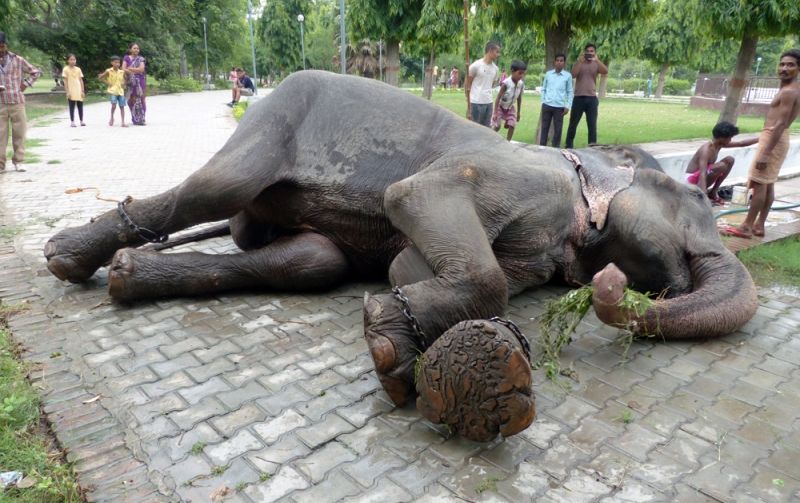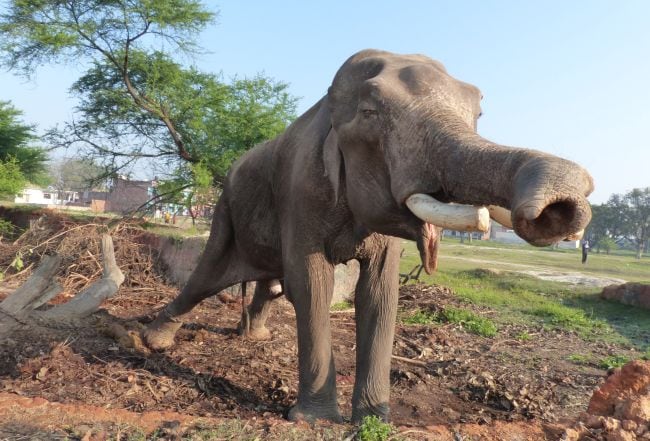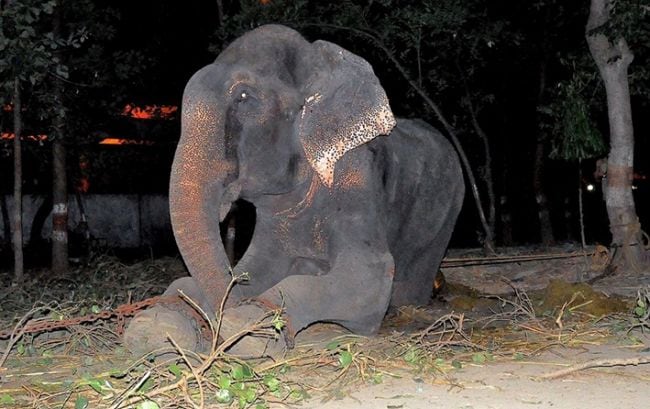- Home/
- How Wildlife SOS Is Saving Abused Elephants - From Circus To Sanctuary
How Wildlife SOS Is Saving Abused Elephants - From Circus To Sanctuary

 A captive elephant fallen due to extreme fatigue
A captive elephant fallen due to extreme fatigueNow, four years later, Lakshmi is down to what is the normal size for female Asian elephants, has new friends, never needs to beg and will get lifetime care. She has the ability to roam free and pools of water to drink from and bathe in.
Established in 1998, Wildlife SOS is a non-profit conservation centre in India, with the primary aim of rescuing and rehabilitating wildlife in distress in the country and preserving India's natural heritage.
In India, there are about 3000 to 3500 captive elephants. The processes of "gentling" them down to be docile enough to stay an obedient captive is an ancient tradition in the country but has no place in a modern society that does not need them either in their fighting armies or in the place of heavy machinery.
Now, the only role in which they still have a particular use is when they are used in our forests to patrol areas that are usually unreachable by car and too arduous by foot. But, even this is now fraught with controversy as in many forests they are also being used to ferry tourists around. Their main use in urban centers now are in temples, festivals, mosque and church processions, tourism centers, circuses and wedding celebrations. Many are also used as tools for begging. The hiring out of an elephant even for an hour can cost as much as Rs. 50,000, but their upkeep can cost a lot more than that. An adult Asian elephant weighs upwards of four tonnes and needs about 150 kg of food and about 150 liters of water on a daily basis. Most of them in captivity are in really bad shape and a long fight is on to phase out captive elephants in the country.
For an enormous animal like elephant, who needs to move frequently, the biggest and most common form of cruelty is the fact that they are chained up almost for the entire time of their captivity. In the wild, a herd will walk for a kilometer to feed and drink water and constantly move as it is very difficult for them to bear their own weight on their four legs when standing still for a long time.
 The most common form of cruelty is to keep them chained for entire time of their captivity
The most common form of cruelty is to keep them chained for entire time of their captivityThe captive elephants have to stand on concrete and tar that burn the soles of their sensitive pads, especially in summer season. Many rescued elephants display infected sores around their feet where the chains have literally cut into their skin. As they are powerful animals, they are tied up tightly with very heavy chains to keep them secure. Even after the "gentling" process they are not easy to control and only respond to their mahouts. To everybody else, they are dangerous. The process of "gentling" them is anything but gentle.
They are isolated, beaten, given commands over and over, treated harshly over any infraction in order to instill fear. They are fed only on performing the commands and learn to quickly follow orders. Some of them with stronger more independent personalities can be treated with great cruelty in order to 'break their spirit'.
Their levels of stress are very high especially in semi urban and urban centers, where they are being tied up for display, and are kept hungry, thirsty and isolated. Elephants are deeply social animals and form long lasting bonds of friends and family. Sometimes in captivity, depending on how many elephants a person can afford - it's only one animal by herself all her life.
This isolation is deeply detrimental to their mental well being. Every year, there are incidents, mainly in Kerala and Karnataka, where elephants completely lose control and ended up not only killing their mahouts but other people as well. Many elephants also die every year from malnutrition, cruelty, road accidents and disease. Some elephants change hands on a regular basis, thereby also becoming stressed by the constant change in their environment and different handlers.
 Being social animals, the isolation in which they are kept can be harmful for their mental health
Being social animals, the isolation in which they are kept can be harmful for their mental healthThere are only a few places for these abused animals to go post they get rescued after complaints over their treatment from animal welfare groups. Two such places are the Wildlife SOS elephant conservation and care centre in Mathura, established in 2010 in collaboration with the UP forest department and the Ban Santour centre in Haryana, established with the help of the Haryana forest department. The Mathura centre houses about 20 elephants right now. The animals here have been rescued from the most horrendous conditions and usually arrive in great distress and terrible conditions. In Haryana, there are three elephants and the centre adjoins Kaleshar wildlife sanctuary and is spread across 300 acres.
Wildlife SOS aims to restore not just their physical health but their mental well being and allow the animals to live out a life of retirement in surroundings that are as close to the wild as possible. The Mathura centre is also set on a huge piece of land, incorporates patches of trees like forests, open grasslands and has built in water pools from which the animal can not only drink water but bathe and lie in as well. They are not chained up and can roam free in the facility. Some of the more damaged ones are kept in isolation until they heal and can be then integrated with the other elephants.
Wildlife SOS also provides high level vet care for not just the elephants; they have also rescued elephants in captivity. They also, work with mahouts in order to train them to give their animals a better care. Wildlife SOS ultimately hopes to end the practice of keeping elephants captive entirely. They worked with single minded purpose to rescue sloth bears from captivity, where they are being used as dancing bears. Thanks to wildlife SOS, this practice has nearly ended in India with over 95% of captive bears now out of that profession. Wildlife SOS runs care centers for the life time care of the SLO bears as well. They also work in the field of leopard rescue and rehabilitation.
Wildlife SOS depends mostly on donations to fund their work and it is a struggle every month to meet their bills. They aim to have the best doctors, best care givers and best quality food for their animals.
Right now, they are participating in an event called the Macy's shop for a cause charity challenge. The organization that raises the most money during this month-long challenge wins 100,000 dollars prize money. Wildlife SOS is currently in the lead but organizations from other countries are closing in and one way in which to help them win and donate money to their cause to help elephants like Laksmi is by donating here.
Right now, the big fight they are in is to entirely stop circuses from using elephants as performers and they are determined to stop it just like they did the trade of dancing bears. Ultimately, Wildlife SOS hopes that they will only need to help animals in the wild and not have to rescue them and keep them in any sort of captivity, even in a care centre.
(Swati Thiyagarajan is an Environment Editor with NDTV. She is at present writing a book "Born Wild", her show on NDTV, on her experiences with conservation and wildlife both in India and Africa, to be published by Bloomsbury.)
Disclaimer: The opinions expressed within this article are the personal opinions of the author. The facts and opinions appearing in the article do not reflect the views of NDTV and NDTV does not assume any responsibility or liability for the same.
also read
Search For The Elusive Snow Leopard In Ladakh's Rumbak Valley
Written by Swati Thiyagarajan
................................ Advertisement ................................
About The Anchor

Born wild is the first long running series on wildlife and conservation on a news channel.
Swati Thiyagarajan has won two Ramnath Goenka Awards for excellence in environment journalism, the Carl Zeiss award for contributing toward tiger conservation amongst others. Apart from the awards, she was also invited to be a jury member at WildScreen Festival in England, the largest wildlife festival in the world. Her film The Animal Communicator has over 5 million hits on YouTube and she has just completed a book on her television series. The book is titled Born Wild and is being published in June 2017 by Bloomsbury India.
................................ Advertisement ................................


